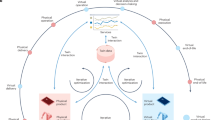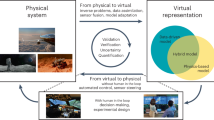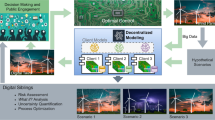Abstract
Mathematical modeling and simulation are moving from being powerful development and analysis tools towards having increased roles in operational monitoring, control and decision support, in which models of specific entities are continually updated in the form of a digital twin. However, current digital twins are largely the result of bespoke technical solutions that are difficult to scale. We discuss two exemplar applications that motivate challenges and opportunities for scaling digital twins, and that underscore potential barriers to wider adoption of this technology.
This is a preview of subscription content, access via your institution
Access options
Access Nature and 54 other Nature Portfolio journals
Get Nature+, our best-value online-access subscription
$29.99 / 30 days
cancel any time
Subscribe to this journal
Receive 12 digital issues and online access to articles
$99.00 per year
only $8.25 per issue
Buy this article
- Purchase on Springer Link
- Instant access to full article PDF
Prices may be subject to local taxes which are calculated during checkout



Similar content being viewed by others
References
Digital Twin: Definition & Value. AIAA Position Paper (AIAA Digital Engineering Integration Committee, 2020).
Bruynseels, K., Santoni de Sio, F. & van den Hoven, J. Digital twins in health care: ethical implications of an emerging engineering paradigm. Front. Genet. 9, 31 (2018).
Corral-Acero, J. et al. The ‘digital twin’ to enable the vision of precision cardiology. Eur. Heart J. 41, 4556–4564 (2020).
Tao, F., Zhang, H., Liu, A. & Nee, A. Y. Digital twin in industry: state-of-the-art. IEEE Trans. Industr. Inform. 15, 2405–2415 (2018).
Wagg, D., Worden, K., Barthorpe, R. & Gardner, P. Digital twins: state-of-the-art and future directions for modeling and simulation in engineering dynamics applications. ASME J. Risk Uncertainty B 6, 030901 (2020).
Podskarbi, M. & Knezevic, D. J. Digital twin for operations—present applications and future digital thread. In Offshore Technology Conference (Offshore Technology Conference, 2020); https://doi.org/10.4043/30553-MS
Bauer, P., Stevens, B. & Hazeleger, W. A digital twin of earth for the green transition. Nat. Clim. Change 11, 80–83 (2021).
Sacks, R., Brilakis, I., Pikas, E., Xie, H. S. & Girolami, M. Construction with digital twin information systems. DCE 1, e14 (2020).
Jans-Singh, M., Leeming, K., Choudhary, R. & Girolami, M. Digital twin of an urban-integrated hydroponic farm. DCE 1, e20 (2020).
Rosen, R., Von Wichert, G., Lo, G. & Bettenhausen, K. D. About the importance of autonomy and digital twins for the future of manufacturing. IFAC-PapersOnLine 48, 567–572 (2015).
Ferguson, S. Apollo 13: The First Digital Twin (Siemens, 2020); https://blogs.sw.siemens.com/simcenter/apollo-13-the-first-digital-twin/
Grieves, M. Product Lifecycle Management: Driving the Next Generation of Lean Thinking (McGraw Hill Professional, 2005).
Grieves, M. & Vickers, J. In Transdisciplinary Perspectives on Complex Systems 85–113 (Springer, 2017).
Glaessgen, E. & Stargel, D. The digital twin paradigm for future NASA and US Air Force vehicles. In 53rd AIAA/ASME/ASCE/AHS/ASC Structures, Structural Dynamics and Materials Conference AIAA 2012-1818 (AIAA, 2012).
Tuegel, E. J., Ingraffea, A. R., Eason, T. G. & Spottswood, S. M. Reengineering aircraft structural life prediction using a digital twin. Int. J. Aerosp. Eng. 2011, 154798 (2011).
Kapteyn, M., Knezevic, D., Huynh, D., Tran, M. & Willcox, K. Data-driven physics-based digital twins via a library of component-based reduced-order models. Int. J. Numer. Methods Eng. https://doi.org/10.1002/nme.6423 (2020).
Ye, Y., Yang, Q., Yang, F., Huo, Y. & Meng, S. Digital twin for the structural health management of reusable spacecraft: a case study. Eng. Fract. Mech. 234, 107076 (2020).
Tadeja, S., Seshadri, P. & Kristensson, P. O. AeroVR: an immersive visualisation system for aerospace design and digital twinning in virtual reality. Aeronaut. J. 124, 1615–1635 (2020).
Niederer, S. A., Lumens, J. & Trayanova, N. A. Computational models in cardiology. Nat. Rev. Cardiol. 16, 100–111 (2019).
Rego, B. V. et al. A noninvasive method for the determination of in vivo mitral valve leaflet strains. Int. J. Numer. Methods Biomed. Eng. 34, e3142 (2018).
Shamanna, P. et al. Reducing HbA1c in type 2 diabetes using digital twin technology-enabled precision nutrition: a retrospective analysis. Diabetes Ther. 11, 2703–2714 (2020).
Lal, A. et al. Development and verification of a digital twin patient model to predict specific treatment response during the first 24 hours of sepsis. Crit. Care Exp. 2, e0249 (2020).
Ahmed, H. & Devoto, L. The potential of a digital twin in surgery. Surg. Innov. https://doi.org/10.1177/1553350620975896 (2020).
Calka, M. et al. Machine-learning based model order reduction of a biomechanical model of the human tongue. Comput. Methods Prog. Biomed. 198, 105786 (2021).
Lauzeral, N. et al. A model order reduction approach to create patient-specific mechanical models of human liver in computational medicine applications. Comput. Methods Prog. Biomed. 170, 95–106 (2019).
Chakshu, N. K., Carson, J., Sazonov, I. & Nithiarasu, P. A semi-active human digital twin model for detecting severity of carotid stenoses from head vibration-a coupled computational mechanics and computer vision method. Int. J. Numer. Methods Biomed. Eng. 35, e3180 (2019).
David A. Hormuth, I. et al. Math, magnets, and medicine: enabling personalized oncology. Expert Rev. Precis. Med. Drug Dev. 0, 1–3 (2021).
Girolami, M., Febrianto, E., Yin, G. & Cirak, F. The statistical finite element method (statFEM) for coherent synthesis of observation data and model predictions. Comput. Methods Appl. Mech. Eng. 375, 113533 (2021).
Jah, M. Why we need a space domain digital twin. Aerosp. Am. 58, 63–64 (2020).
Boyle, P. M. et al. Computationally guided personalized targeted ablation of persistent atrial fibrillation. Nat. Biomed. Eng. 3, 870–879 (2019).
Prakosa, A. et al. Personalized virtual-heart technology for guiding the ablation of infarct-related ventricular tachycardia. Nat. Biomed. Eng. 2, 732–740 (2018).
Sidhu, B. S. et al. Combined computed tomographic perfusion and mechanics with predicted activation pattern can successfully guide implantation of a wireless endocardial pacing system. EP Europace 22, 298–298 (2020).
Strocchi, M. et al. A publicly available virtual cohort of four-chamber heart meshes for cardiac electro-mechanics simulations. PLoS One 15, e0235145 (2020).
Kayvanpour, E. et al. Towards personalized cardiology: multi-scale modeling of the failing heart. PLoS One 10, e0134869 (2015).
Womack, J. P., Jones, D. T. & Roos, D. The Machine That Changed the World: The Story of Lean Production (Harper Collins, 1991).
Zienkiewicz, O. C. & Taylor, R. L. The Finite Element Method Vol. 2 (Butterworth-Heinemann, 2000).
Ivo Babuska, J. R. W. & Strouboulis, T. The Finite Element Method and its Reliability (Oxford Univ. Press, 2001).
Hughes, T. J., Franca, L. P. & Balestra, M.A new finite element formulation for computational fluid dynamics: V. Circumventing the Babuška–Brezzi condition: a stable Petrov–Galerkin formulation of the stokes problem accommodating equal-order interpolations. Comput. Methods Appl. Mech. Eng. 59, 85–99 (1986).
Oden, J. T. Finite Elements of Nonlinear Continua (Courier Corporation, 2006).
Duffin, C., Cripps, E., Stemler, T. & Girolami, M. Statistical finite elements for misspecified models. Proc. Natl Acad. Sci. USA 118, e2015006118 (2021).
Rüde, U., Willcox, K., Curfman McInnes, L. & De Sterck, H. Research and education in computational science and engineering. SIAM Rev. 60, 707–754 (2018).
Donoho, D. 50 years of data science. J. Comput. Graph. Stats 26, 745–766 (2017).
Han, J., Jentzen, A. & Weinan, E. Solving high-dimensional partial differential equations using deep learning. Proc. Natl Acad. Sci. USA 115, 8505–8510 (2018).
Whalen, J. Hottest job in China’s hinterlands: teaching AI to tell a truck from a turtle. Washington Post (26 September 2019); https://www.washingtonpost.com/business/2019/09/26/hottest-job-chinas-hinterlands-teaching-ai-tell-truck-turtle/
Lichter, J., Li, H. & Sachse, F. B. Measurement of strain in cardiac myocytes at micrometer scale based on rapid scanning confocal microscopy and non-rigid image registration. Annals Biomed. Eng. 44, 3020–3031 (2016).
Clayton, R. H. et al. Models of cardiac tissue electrophysiology: progress, challenges and open questions. Prog. Biophys. Mol. Biol. 104, 22–48 (2011).
Bostanabad, R. et al. in Uncertainty Quantification in Multiscale Materials Modeling 355–384 (Elsevier, 2020).
Bostanabad, R., Bui, A. T., Xie, W., Apley, D. W. & Chen, W. Stochastic microstructure characterization and reconstruction via supervised learning. Acta Materialia 103, 89–102 (2016).
Mendizabal, A., Márquez-Neila, P. & Cotin, S. Simulation of hyperelastic materials in real-time using deep learning. Med. Image Anal. 59, 101569 (2020).
Brunet, J. et al. Physics-based deep neural network for augmented reality during liver surgery. In 22nd International Conference on Medical Image Computing and Computer Assisted Intervention (eds Shen, D. et al.) Vol. 11768, 137–145 (Springer, 2019); https://doi.org/10.1007/978-3-030-32254-0_16
Zhang, W., Rossini, G., Kamensky, D., Bui-Thanh, T. & Sacks, M. S. Isogeometric finite element-based simulation of the aortic heart valve: integration of neural network structural material model and structural tensor fiber architecture representations. Int. J. Numer. Methods in Biomed. Eng. 37, e3438 (2021).
Teichert, G., Natarajan, A., der Ven, A. V. & Garikipati, K. Machine learning materials physics: integrable deep neural networks enable scale bridging by learning free energy functions. Comput. Methods Appl. Mech. Eng. 353, 201–216 (2019).
Oden, J. T., Babuška, I. & Faghihi, D. in Encyclopedia of Computational Mechanics 2nd edn, 1–26 (John Wiley and Sons, 2017).
Roy, C. J. & Oberkampf, W. L.A comprehensive framework for verification, validation, and uncertainty quantification in scientific computing. Comput. Methods Appl. Mech. Eng. 200, 2131–2144 (2011).
Council, N. R. et al. Assessing the Reliability of Complex Models: Mathematical and Statistical Foundations of Verification, Validation, and Uncertainty Quantification (National Academies, 2012).
Morrison, T. M., Pathmanathan, P., Adwan, M. & Margerrison, E. Advancing regulatory science with computational modeling for medical devices at the FDA’s office of science and engineering laboratories. Front. Med. 5, 241 (2018).
AIAA Guide for the Verification and Validation of Computational Fluid Dynamics Simulations (AIAA, 1998).
Brunton, S. L. et al. Data-driven aerospace engineering: reframing the industry with machine learning. Preprint at https://arxiv.org/abs/2008.10740 (2020).
Holzinger, A., Langs, G., Denk, H., Zatloukal, K. & Müller, H.Causability and explainability of artificial intelligence in medicine. WIREs Data Min. Knowl. 9, e1312 (2019).
Coveney, P. V., Dougherty, E. R. & Highfield, R. R. Big data need big theory too. Philos. Trans. R. Soc. A 374, 20160153 (2016).
Stuart, A. M. Inverse problems: a Bayesian perspective. Acta Numer. 19, 451–559 (2010).
Biegler, L. et al. Large-Scale Inverse Problems and Quantification of Uncertainty Vol. 712 (John Wiley & Sons, 2011).
Darema, F. Dynamic data driven applications systems: a new paradigm for application simulations and measurements. In International Conference on Computational Science (eds Bubak, M. et al.) 662–669 (Springer, 2004).
Blasch, E., Ravela, S. & Aved, A. Handbook of Dynamic Data Driven Applications Systems (Springer, 2018).
Kraft, E. M. The Air Force digital thread/digital twin-life cycle integration and use of computational and experimental knowledge. In 54th AIAA Aerospace Sciences Meeting AIAA 2016-0897 (2016).
Singh, V. & Willcox, K. E. Engineering design with digital thread. AIAA J. 56, 4515–4528 (2018).
Lu, D. Creating an AI can be five times worse for the planet than a car. New Scientist (6 June 2019); https://www.newscientist.com/article/2205779-creating-an-ai-can-be-five-times-worse-for-the-planet-than-a-car
Lumens, J. Creating your own virtual patient with CircAdapt. Eur. Heart J. 35, 335–337 (2014).
Liebeck, R. H. Design of the blended wing body subsonic transport. J. Aircraft 41, 10–25 (2004).
Peterson, D. R. & Bronzino, J. D. Biomechanics: Principles and Applications (CRC, 2007).
Acknowledgements
S.N. acknowledges support from the UK Engineering and Physical Sciences Research Council (grant nos. EP/M012492/1, NS/A000049/1 and EP/P01268X/1), the British Heart Foundation (grant nos. PG/15/91/31812, PG/13/37/30280, SP/18/6/33805), US National Institutes of Health (grant no. NIH R01-HL152256), European Research Council (grant no. ERC PREDICT-HF 864055), Wellcome Trust (grant no. WT 203148/Z/16/Z) and Kings Health Partners London National Institute for Health Research (NIHR) Biomedical Research Centre. M.S. acknowledges the Moss Heart Foundation, the Cain Foundation and NIH grants (grant nos. R01 HL073021, R01 HL142504, R01 HL129077 and R01 HL103723). M.G. acknowledges support from the UK Engineering and Physical Sciences Research Council (grant nos. EP/T000414/1, EP/R018413/2, EP/P020720/2, EP/R034710/1, EP/R004889/1), as well as a Research Chair supported by the Royal Academy of Engineering and Lloyds Register Foundation. K.W. acknowledges support from the US Department of Energy (grant no. DE-SC0021239) and the US Air Force Office of Scientific Research (grant no. FA9550-21-1-0084). The authors thank G. Foss of Texas Advanced Computing Center (TACC) for creating the heart image in Fig. 2.
Author information
Authors and Affiliations
Contributions
All authors contributed to the conception, writing and editing of this manuscript.
Corresponding author
Ethics declarations
Competing interests
The authors declare no competing interests.
Additional information
Peer review information Nature Computational Science thanks Steven Brunton, Kristi Morgansen and the other, anonymous, reviewer(s) for their contribution to the peer review of this work. Handling editor: Fernando Chirigati, in collaboration with the Nature Computational Science team.
Publisher’s note Springer Nature remains neutral with regard to jurisdictional claims in published maps and institutional affiliations.
Rights and permissions
About this article
Cite this article
Niederer, S.A., Sacks, M.S., Girolami, M. et al. Scaling digital twins from the artisanal to the industrial. Nat Comput Sci 1, 313–320 (2021). https://doi.org/10.1038/s43588-021-00072-5
Received:
Accepted:
Published:
Issue Date:
DOI: https://doi.org/10.1038/s43588-021-00072-5
This article is cited by
-
Digital twins in city planning
Nature Computational Science (2024)
-
Advancements and challenges of digital twins in industry
Nature Computational Science (2024)
-
The role of complexity for digital twins of cities
Nature Computational Science (2023)
-
The transformative potential of machine learning for experiments in fluid mechanics
Nature Reviews Physics (2023)
-
A global sensitivity analysis of a mechanistic model of neoadjuvant chemotherapy for triple negative breast cancer constrained by in vitro and in vivo imaging data
Engineering with Computers (2023)



